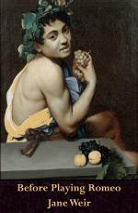reviewed by the Judge
Tensions of language and communication are at the heart of Before Playing Romeo, the second poetry collection by Jane Weir. “I know not how to tell you who I am,” a line from Romeo and Juliet, is the epigraph for the poem which gives the volume its title, and this concern recurs throughout: “you do not know me, / nor I you and never will,” she declares dryly in "Window". This title is in turn revealing; the ‘window’ is another recurrent trope in BPR, a symbolic point of passage through which we see in and are seen into. The image is wilfully ambiguous, and the rest of her collection follows suit. Most of the poems which Weir addresses to an acquaintance or an interlocutor subtly double up as messages from the poet to the reader. One is constantly on the edge between spectator and addressee, and like Romeo himself, the meaning of these poems is constantly in play. Language is correspondingly elusive and unpredictable (though in its usage Weir has some clear debts towards other past poets; Marianne Moore, Sylvia Plath, Elizabeth Bishop), internal rhymes are scattered across poems that would otherwise seem unstructured, and when a scene finally seems to be depicting an instance of communication, it is more often through the characters’ mutual silence than through their mutual speech.
Milan, Venice, Carrickfergus; from Ireland to Italy, BPR sweeps over a wealth of Mediterranean experiences.
It is on this linguistic plane of playfulness and sudden epiphanies, of skidding and dipping through surfaces of meaning, that the collection takes us on its thematic voyage through places and memories. Milan, Venice, Carrickfergus; from Ireland to Italy, BPR sweeps over a wealth of Mediterranean experiences. These experiences are charged, intense with recollection and atmosphere. Weir is at her best when she can bring together the ambiguity of her language with the concreteness and stability of her memories. The ‘Ralph’ poems, dedicated to her husband, are an example of that (“Even in this tender heat / the flies persist / as though I’m / a house party / and my eyes / the ballroom floor / of their mansion, / where they deposit gifts / around my irises / as if they are card tables” – "Ralph in Florence").
The recollection of experience can be at once familiar and alienating, in accordance with the ‘play’ of the text. Some images tend to unsettle as much as they please, such as the sky which ‘belched red gold’ of "In Our Dinner Hour, Wigan" or the ‘monstrous’ sun of "First Night with the Cave Hill Behind". The process is, of course, very self-aware; several of Weir’s poems are about the process or act of creating the text ("Via Gellia"; "Exile", "Artists Corner"; "At Helens’ Bay"). Yet it is precisely that which goes beyond the text, or which exists behind it, which in these poems is the realm of communication – the other side of the window. Since direct, binary communication through the Word is not possible, the most that these poems aim for (and, by extension, the most that we can attain in our experience) is not a steady stream of exchange, but a fleeting moment of contact, the ‘tremor before flight,’ as she beautifully puts it in "Before Playing Romeo", in which we are not so much constantly talking or hearing but ‘nearly touching’ ("The Cave of the Golden Calf").
The cover of Before Playing Romeo consists of a painting of Bacchus by Caravaggio. This, along with the reference to Romeo and some of the poem titles ("The Cave of the Golden Calf", "Copper Vase", "Harpies and Phineus"), suggests an interest in the flourishing historical periods of the Mediterranean lands she visits in her poems – the classical ages and the Renaissance. This expectation, however, is not fulfilled; her poems never go beyond a cursory, casual reference to Apollo or to Zeus. This is a shame, because "Homage", a poem dedicated to Charlotte Mew and Christina Rossetti, sees Weir engaging very successfully with the modern mythologies surrounding these two poets, and suggests she would have the competence to deal with more ancient ones as well. Some of her poems might benefit from being steeped not only in the rich atmospheres and climates of the lands they visit, but also in the equally rich cultures which matured in them, and which, in BPR, are remarkable only for their absence.
But then, perhaps these themes go beyond the interests of a collection as intimate as that of Weir, and as her choice of epigraphs suggests (Oscar Wilde, Colette, James Baldwin), Jane Weir is a modernist through and through. In a postmodern age which often forgets the value of concrete, sensual experience (or at least refuses to express it), it is refreshing to read poems which take us back to lanes with soft earth under our feet, to tender sunlight and the wind that ‘froths the sea.’ They might not always be as historically erudite as one may wish, but they are textually subtle, often inspiring, and pleasingly mature. I mean it as a true compliment when I say that they are a good old wine in new bottles – a Piedmontese Barolo, to be precise, produced in Cuneo, by the Borgogno family, and seasoned six years.










